Wafer-Scale Room-Temperature Bonding of Smooth Au/Ti-Based Getter Layer for Vacuum Packaging
Abstract
1. Introduction
2. Materials and Methods
3. Results
3.1. Smoothening Au/Ti Getter Film by Conventional TS Technique
3.2. Transfering Au/Ti/Au Getter Layer from Template to Packaging Substrate
4. Discussion
5. Conclusions
Supplementary Materials
Author Contributions
Funding
Institutional Review Board Statement
Informed Consent Statement
Data Availability Statement
Conflicts of Interest
References
- Kim, J.; Jeong, B.; Chiao, M.; Lin, L. Ultrasonic Bonding for MEMS Sealing and Packaging. IEEE Trans. Adv. Packag. 2009, 32, 461–467. [Google Scholar] [CrossRef]
- Dhayal, M.; Jeong, H.G.; Choi, J.S. Use of Plasma Polymerisation Process for Fabrication of Bio-MEMS for Micro-Fluidic Devices. Appl. Surf. Sci. 2005, 252, 1710–1715. [Google Scholar] [CrossRef]
- Knechtel, R. Low Temperature Wafer Bonding for MEMS Processes and 3D Integration. In Proceedings of the 2012 3rd IEEE International Workshop on Low Temperature Bonding for 3D Integration, Tokyo, Japan, 22–23 May 2012; pp. 258–262. [Google Scholar] [CrossRef]
- Takigawa, R.; Higurashi, E.; Suga, T.; Sawada, R. Room-Temperature Bonding of Vertical-Cavity Surface-Emitting Laser Chips on Si Substrates Using Au Microbumps in Ambient Air. Appl. Phys. Express 2008, 1, 1122011–1122012. [Google Scholar] [CrossRef]
- Lee, C.; Yu, A.; Yan, L.; Wang, H.; He, J.H.; Zhang, Q.X.; Lau, J.H. Characterization of Intermediate In/Ag Layers of Low Temperature Fluxless Solder Based Wafer Bonding for MEMS Packaging. Sensors Actuators A Phys. 2009, 154, 85–91. [Google Scholar] [CrossRef]
- Lin, L. MEMS Post-Packaging by Localized Heating and Bonding. IEEE Trans. Adv. Packag. 2000, 23, 608–616. [Google Scholar] [CrossRef]
- Tofteberg, H.R.; Schjølberg-Henriksen, K.; Fasting, E.J.; Moen, A.S.; Taklo, M.M.V.; Poppe, E.U.; Simensen, C.J. Wafer-Level Au–Au Bonding in the 350–450 °C Temperature Range. J. Micromech. Microeng. 2014, 24, 084002. [Google Scholar] [CrossRef]
- Higurashi, E.; Okumura, K.; Kunimune, Y.; Suga, T.; Hagiwara, K. Room-Temperature Bonding of Wafers with Smooth Au Thin Films in Ambient Air Using a Surface-Activated Bonding Method. IEICE Trans. Electron. 2017, E100C, 156–160. [Google Scholar] [CrossRef]
- Takigawa, R.; Iwanabe, K.; Shuto, T.; Takao, T.; Asano, T. Room-Temperature Hermetic Sealing by Ultrasonic Bonding with Au Compliant Rim. Jpn. J. Appl. Phys. 2014, 53, 06JM05. [Google Scholar] [CrossRef]
- Wang, X.; Bleiker, S.J.; Edinger, P.; Errando-Herranz, C.; Roxhed, N.; Stemme, G.; Gylfason, K.B.; Niklaus, F. Wafer-Level Vacuum Sealing by Transfer Bonding of Silicon Caps for Small Footprint and Ultra-Thin MEMS Packages. J. Microelectromech. Syst. 2019, 28, 460–471. [Google Scholar] [CrossRef]
- Yamamoto, M.; Matsumae, T.; Kurashima, Y.; Takagi, H.; Suga, T.; Takamatsu, S.; Itoh, T.; Higurashi, E. Effect of Au Film Thickness and Surface Roughness on Room-Temperature Wafer Bonding and Wafer-Scale Vacuum Sealing by Au-Au Surface Activated Bonding. Micromachines 2020, 11, 454. [Google Scholar] [CrossRef]
- Wu, M.; Moulin, J.; Lani, S.; Hallais, G.; Renard, C.; Bosseboeuf, A. Low Temperature Activation of Au/Ti Getter Film for Application to Wafer-Level Vacuum Packaging. Jpn. J. Appl. Phys. 2015, 54, 030220. [Google Scholar] [CrossRef]
- Kurashima, Y.; Matsumae, T.; Higurashi, E.; Yanagimachi, S.; Kusui, T.; Watanabe, M.; Takagi, H. Application of Thin Au/Ti Double-Layered Films as Both Low-Temperature Bonding Layer and Residual Gas Gettering Material for MEMS Encapsulation. Microelectron. Eng. 2021, 238, 111513. [Google Scholar] [CrossRef]
- Maidul Haque, S.; Biswas, A.; Bhattacharya, D.; Tokas, R.B.; Bhattacharyya, D.; Sahoo, N.K. Surface Roughness and Interface Width Scaling of Magnetron Sputter Deposited Ni/Ti Multilayers. J. Appl. Phys. 2013, 114, 103508. [Google Scholar] [CrossRef]
- Okada, H.; Itoh, T.; Suga, T. Effects of Surface Profiles of As-Sputtered Au Thin Films on Room Temperature Seal-Bonding. J. Japan Inst. Electron. Packag. 2009, 12, 534–541. [Google Scholar] [CrossRef]
- Okada, H.; Itoh, T.; Suga, T. The Influence of Surface Profiles on Leakage in Room Temperature Seal-Bonding. Sensors Actuators A Phys. 2008, 144, 124–129. [Google Scholar] [CrossRef]
- Karbasian, G.; Fay, P.J.; Grace Xing, H.; Orlov, A.O.; Snider, G.L. Chemical Mechanical Planarization of Gold. J. Vac. Sci. Technol. A Vac. Surf. Film. 2014, 32, 021402. [Google Scholar] [CrossRef]
- Yamamoto, M.; Matsumae, T.; Kurashima, Y.; Takagi, H.; Suga, T.; Itoh, T.; Higurashi, E. Growth Behavior of Au Films on SiO2 Film and Direct Transfer for Smoothing Au Surfaces. Int. J. Autom. Technol. 2019, 13, 254–260. [Google Scholar] [CrossRef]
- Higurashi, E.; Yamamoto, M.; Nishimura, R.; Matsumae, T.; Kurashima, Y.; Takagi, H.; Suga, T.; Itoh, T. Formation of Smooth Au Surfaces Produced by Multiple Thin-Film Transfer Process Based on Template Stripping for Low-Temperature Bonding. In Proceedings of the 2020 IEEE 70th Electronic Components and Technology Conference (ECTC), Orlando, FL, USA, 3–30 June 2020; pp. 223–228. [Google Scholar] [CrossRef]
- Ederth, T. Template-Stripped Gold Surfaces with 0.4-Nm Rms Roughness Suitable for Force Measurements: Application to the Casimir Force in the 20–100-Nm Range. Phys. Rev. A 2000, 62, 062104. [Google Scholar] [CrossRef]
- Lee, K.L.; Chen, P.W.; Wu, S.H.; Huang, J.B.; Yang, S.Y.; Wei, P.K. Enhancing Surface Plasmon Detection Using Template-Stripped Gold Nanoslit Arrays on Plastic Films. ACS Nano 2012, 6, 2931–2939. [Google Scholar] [CrossRef]
- Vogel, N.; Zieleniecki, J.; Köper, I. As Flat as It Gets: Ultrasmooth Surfaces from Template-Stripping Procedures. Nanoscale 2012, 4, 3820. [Google Scholar] [CrossRef]
- Thu, L.H.H.; Matsumae, T.; Kurashima, Y.; Takagi, H.; Higurashi, E. Surface Smoothing of Au Plated Films by Template Stripping towards Low-Temperature Bonding for 3D Integration. In Proceedings of the 2021 7th International Workshop on Low Temperature Bonding for 3D Integration (LTB-3D), Nara, Japan, 5–11 October 2021. [Google Scholar] [CrossRef]
- Esashi, M. Wafer Level Packaging of MEMS. J. Micromech. Microeng. 2008, 18, 073001. [Google Scholar] [CrossRef]
- Matsumae, T.; Kurashima, Y.; Takagi, H. Surface Activated Bonding of Ti/Au and Ti/Pt/Au Films after Vacuum Annealing for MEMS Packaging. Microelectron. Eng 2018, 197, 76–82. [Google Scholar] [CrossRef]
- Kariya, S.; Matsumae, T.; Kurashima, Y.; Takagi, H.; Hayase, M.; Higurashi, E. Bonding Formation and Gas Absorption Using Au/Pt/Ti Layers for Vacuum Packaging. Microsyst. Nanoeng. 2022, 8, 1–9. [Google Scholar] [CrossRef] [PubMed]
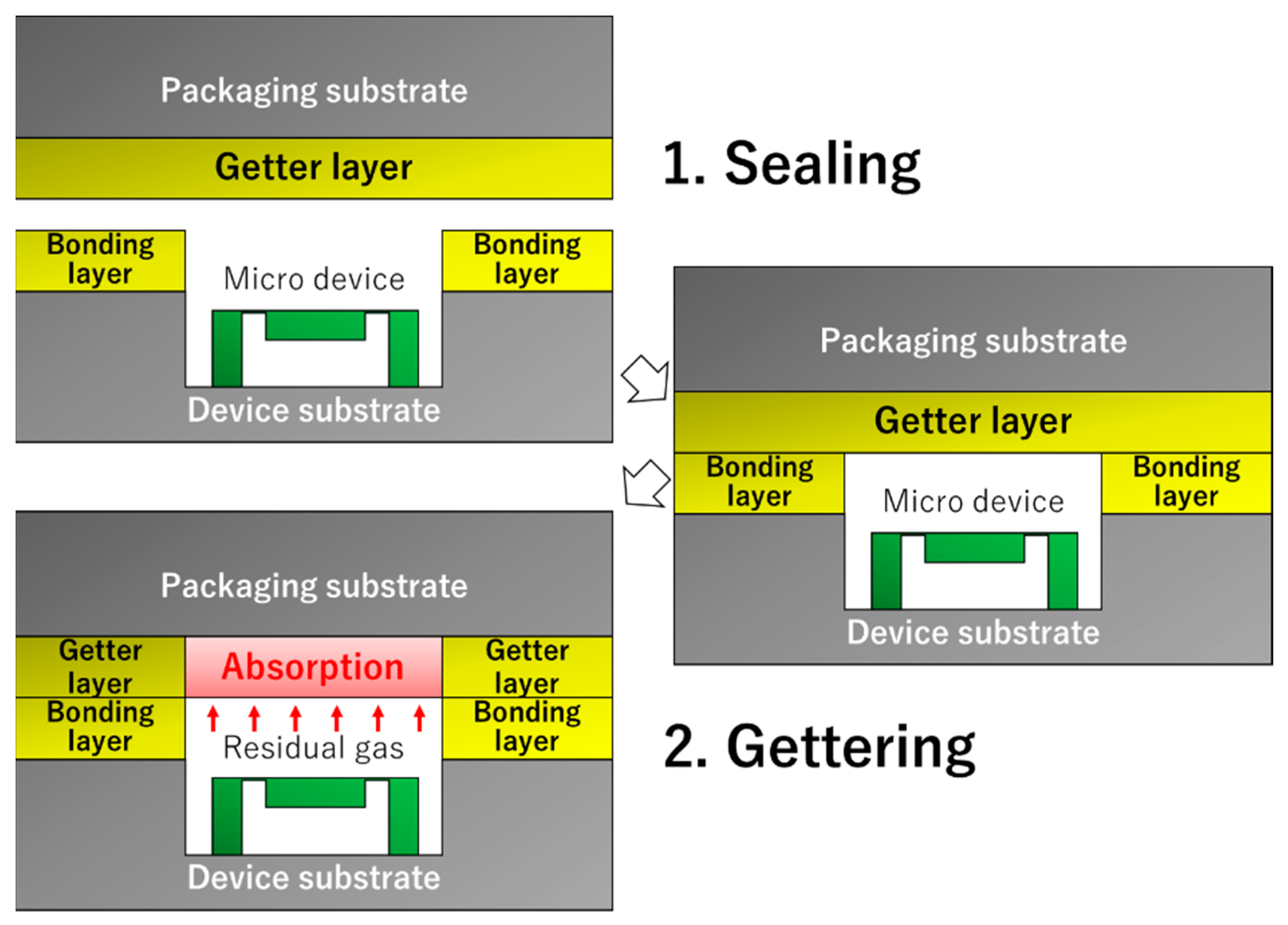

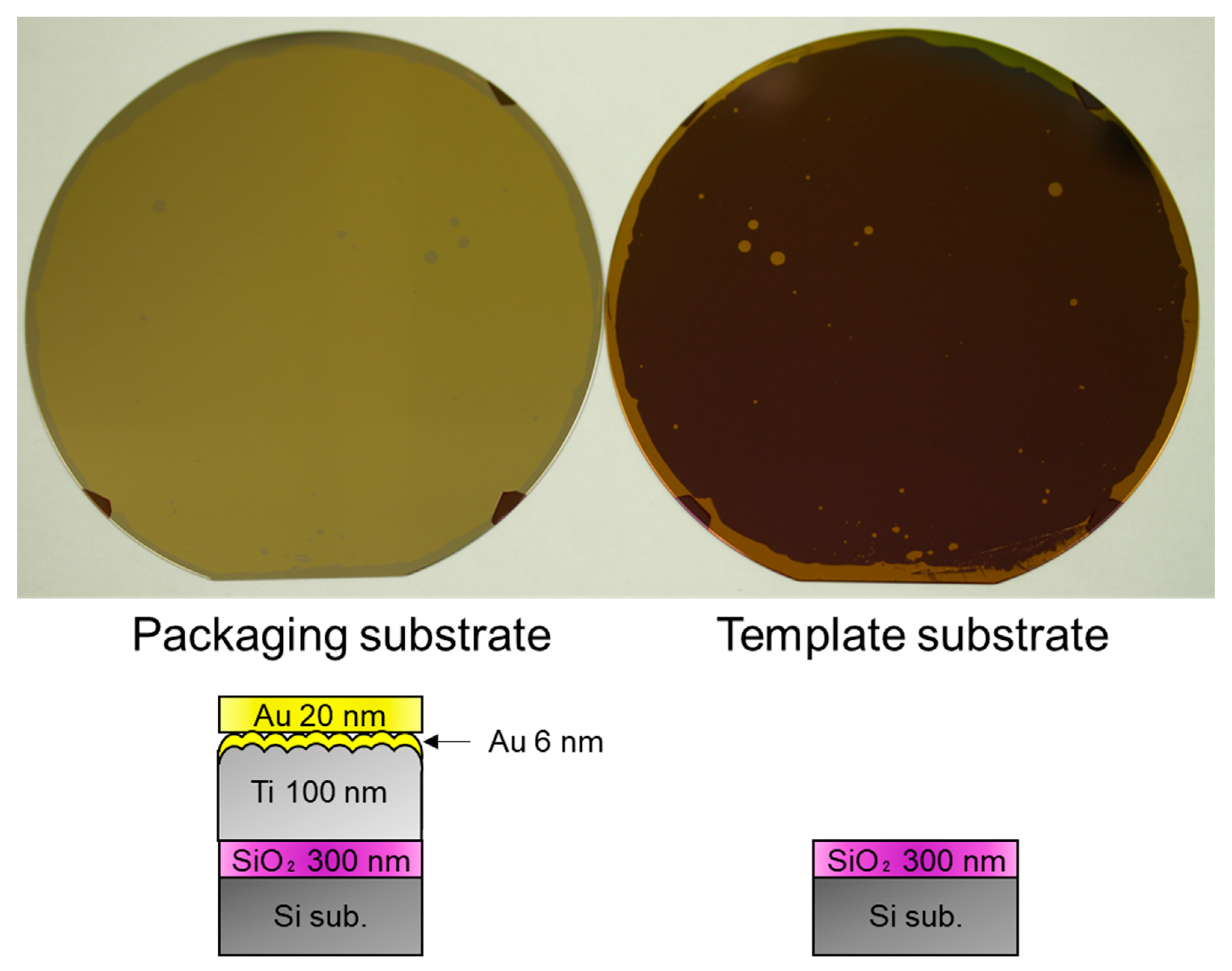
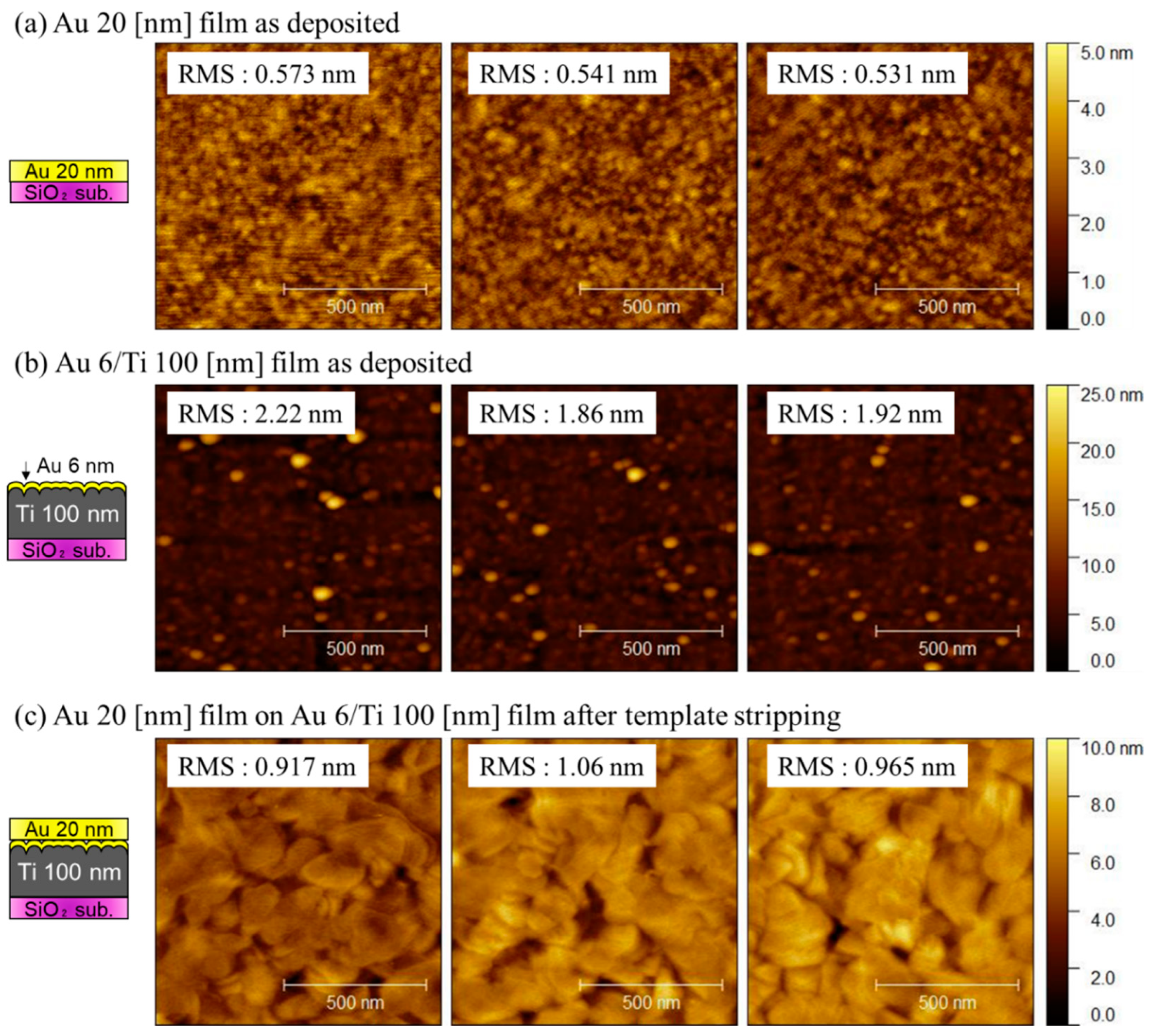

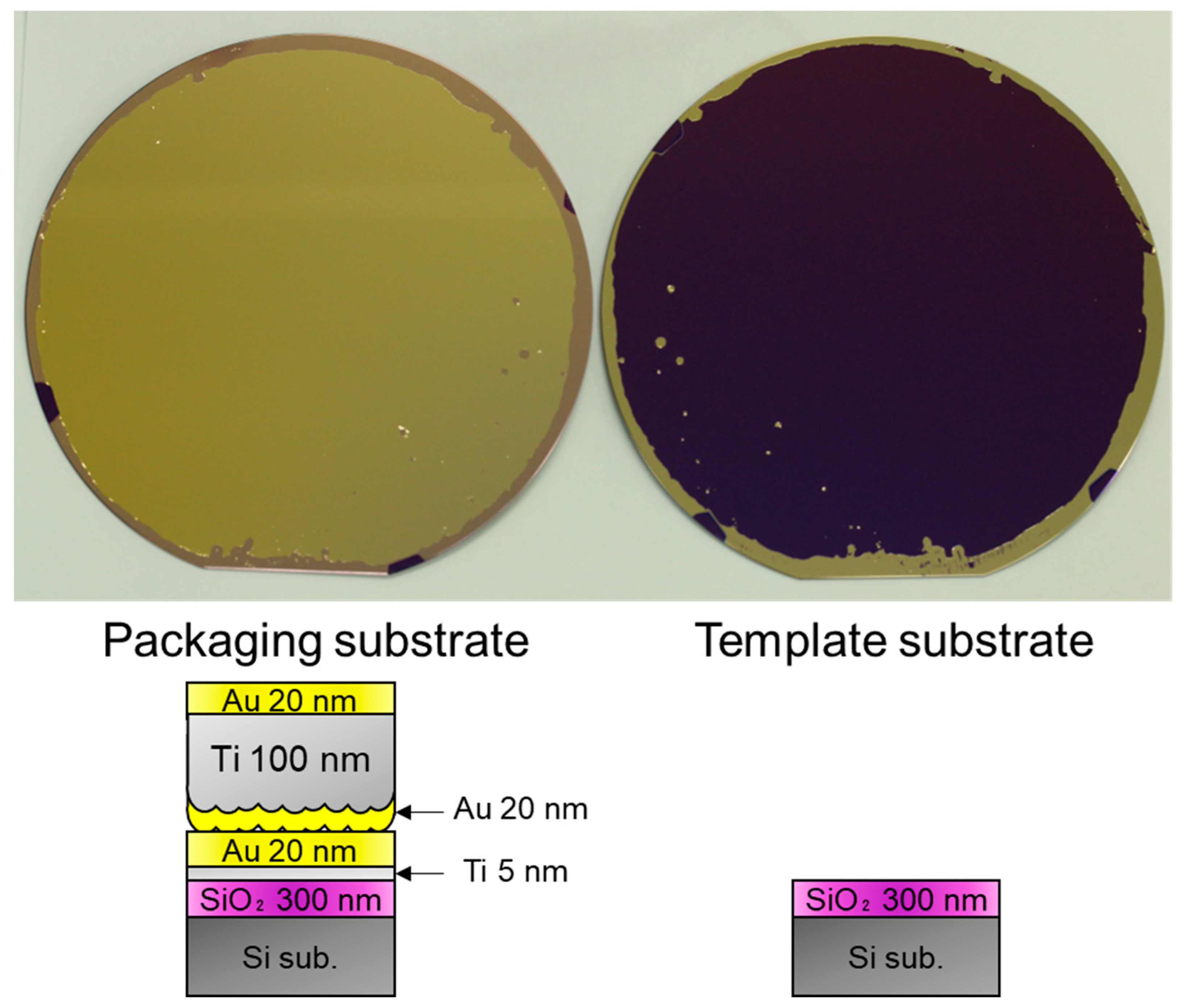
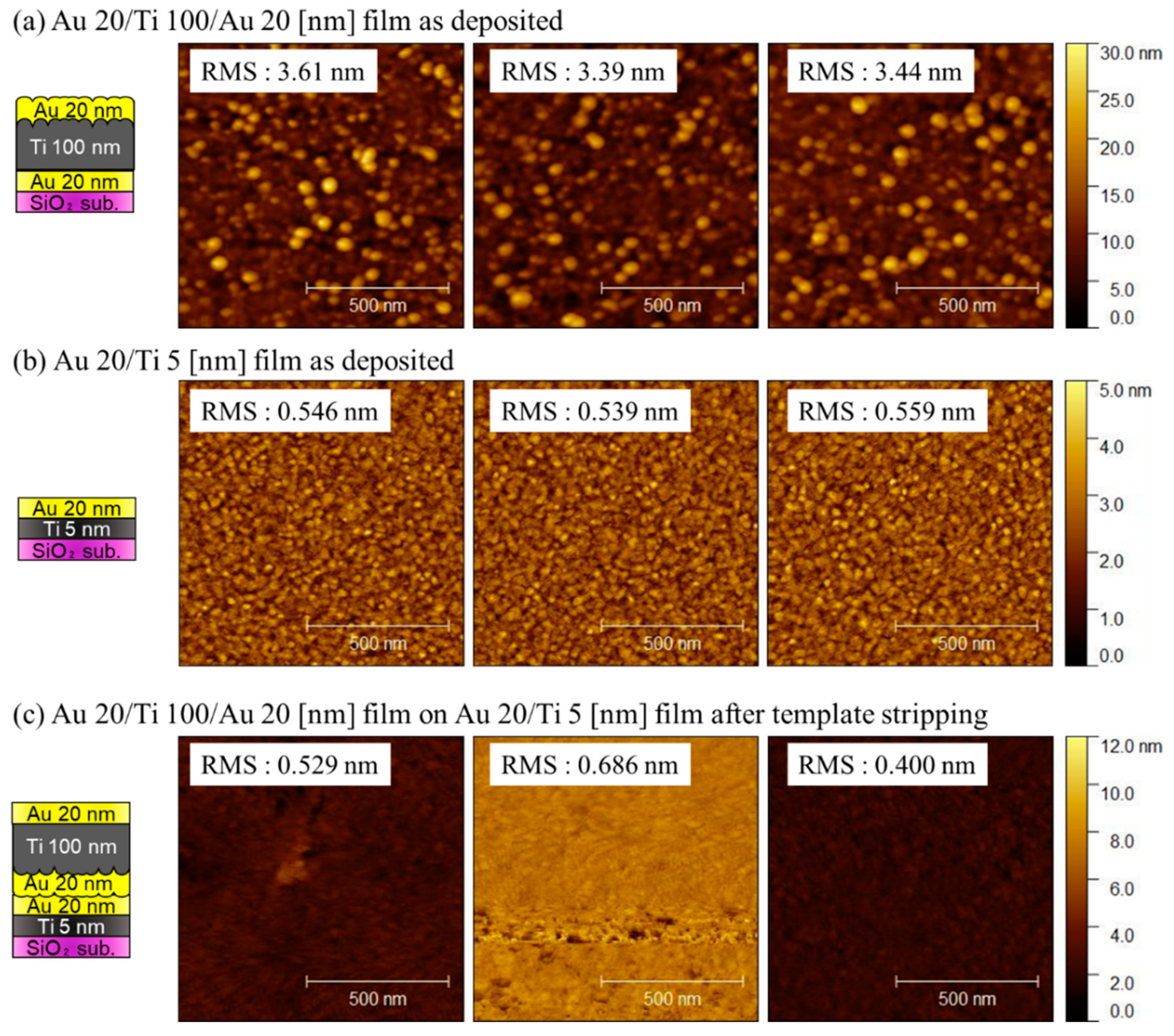

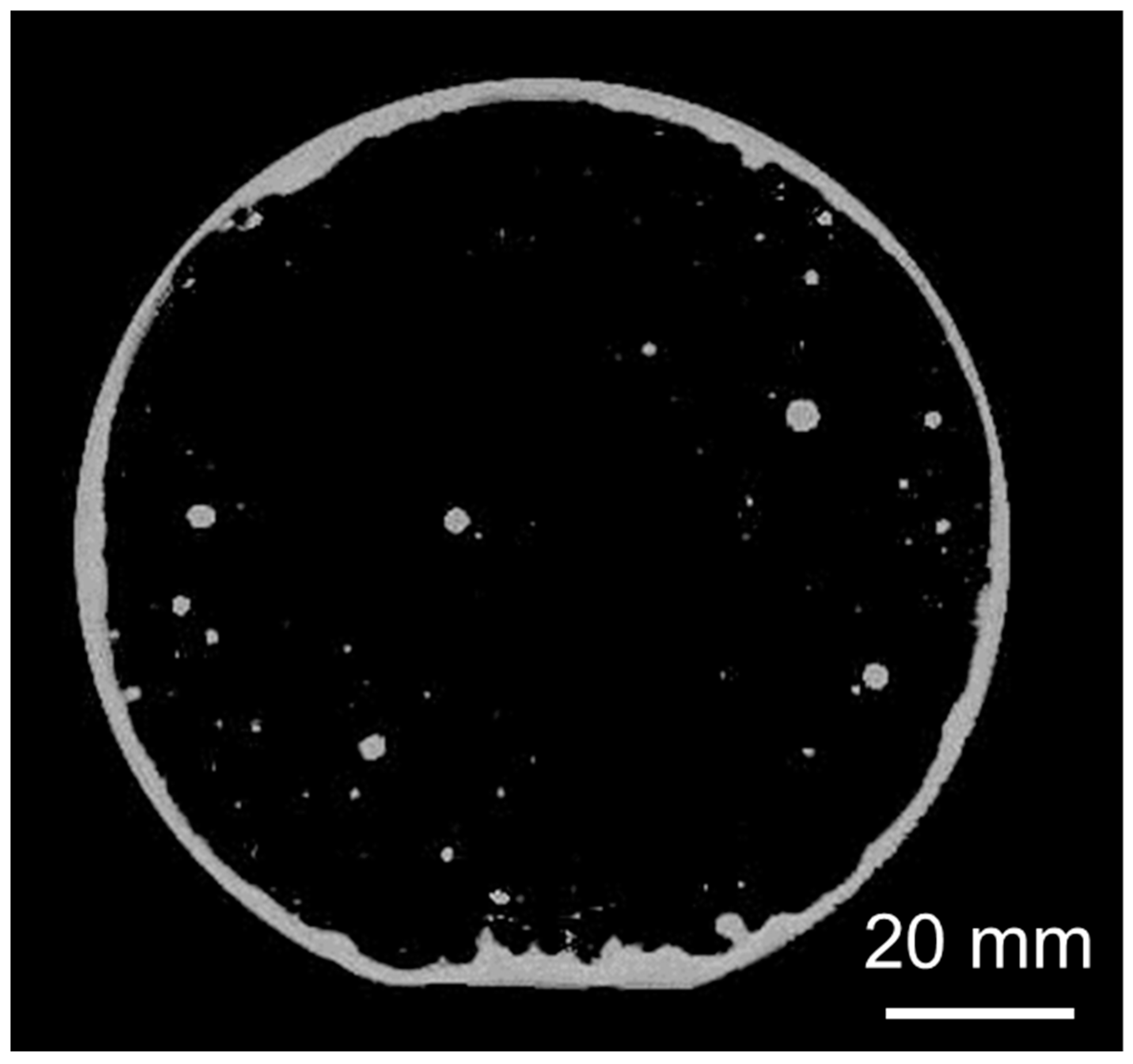
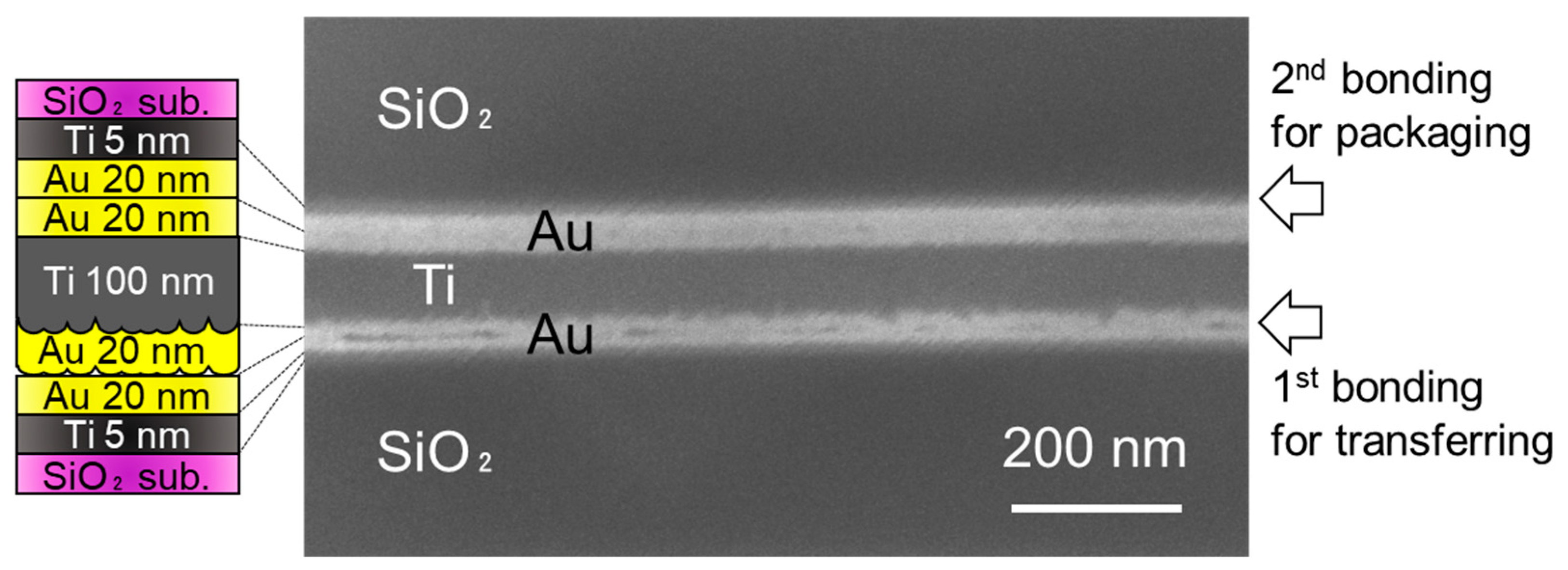
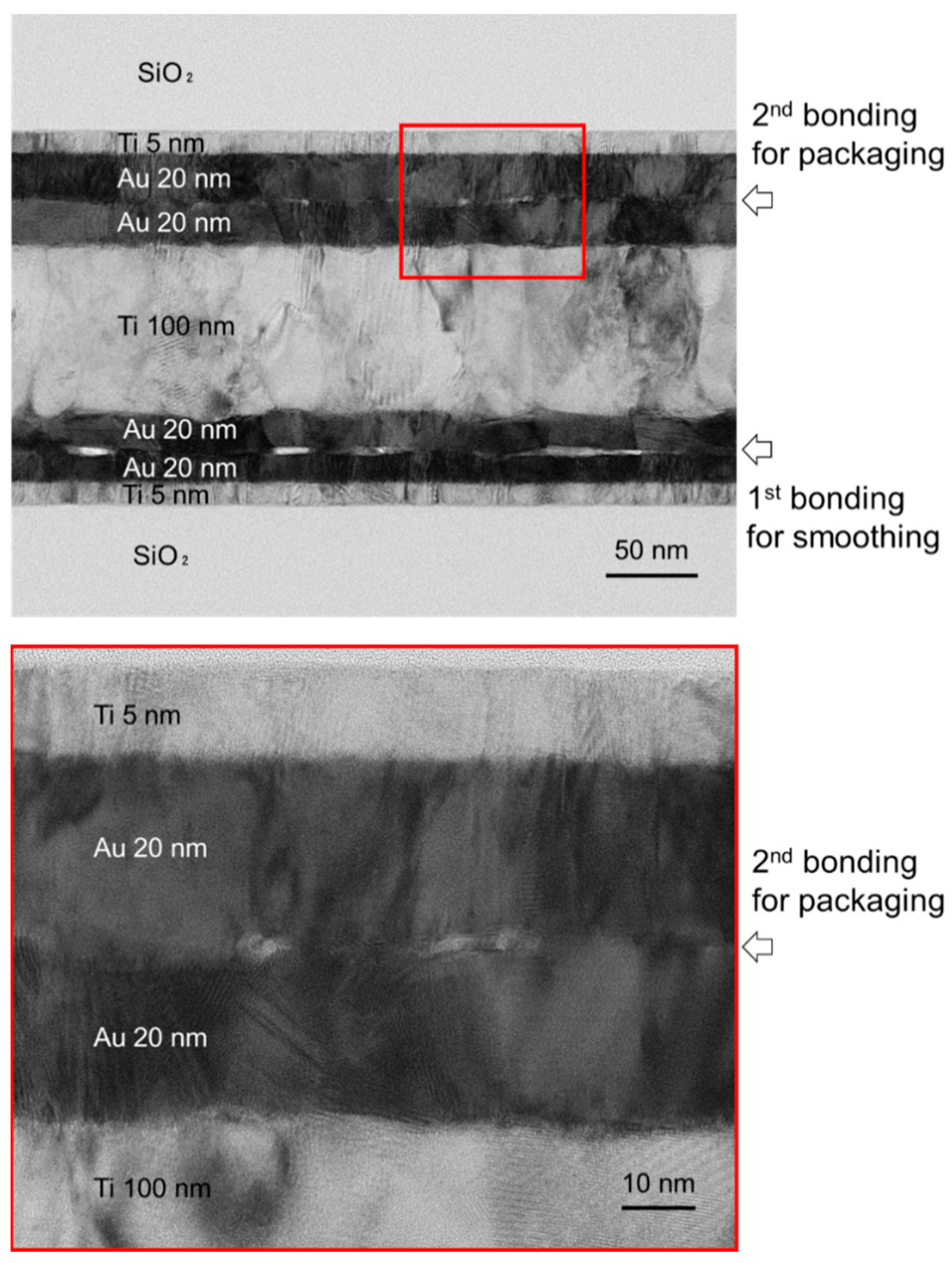
Publisher’s Note: MDPI stays neutral with regard to jurisdictional claims in published maps and institutional affiliations. |
© 2022 by the authors. Licensee MDPI, Basel, Switzerland. This article is an open access article distributed under the terms and conditions of the Creative Commons Attribution (CC BY) license (https://creativecommons.org/licenses/by/4.0/).
Share and Cite
Matsumae, T.; Kariya, S.; Kurashima, Y.; Thu, L.H.H.; Higurashi, E.; Hayase, M.; Takagi, H. Wafer-Scale Room-Temperature Bonding of Smooth Au/Ti-Based Getter Layer for Vacuum Packaging. Sensors 2022, 22, 8144. https://doi.org/10.3390/s22218144
Matsumae T, Kariya S, Kurashima Y, Thu LHH, Higurashi E, Hayase M, Takagi H. Wafer-Scale Room-Temperature Bonding of Smooth Au/Ti-Based Getter Layer for Vacuum Packaging. Sensors. 2022; 22(21):8144. https://doi.org/10.3390/s22218144
Chicago/Turabian StyleMatsumae, Takashi, Shingo Kariya, Yuichi Kurashima, Le Hac Huong Thu, Eiji Higurashi, Masanori Hayase, and Hideki Takagi. 2022. "Wafer-Scale Room-Temperature Bonding of Smooth Au/Ti-Based Getter Layer for Vacuum Packaging" Sensors 22, no. 21: 8144. https://doi.org/10.3390/s22218144
APA StyleMatsumae, T., Kariya, S., Kurashima, Y., Thu, L. H. H., Higurashi, E., Hayase, M., & Takagi, H. (2022). Wafer-Scale Room-Temperature Bonding of Smooth Au/Ti-Based Getter Layer for Vacuum Packaging. Sensors, 22(21), 8144. https://doi.org/10.3390/s22218144






